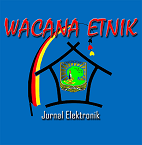KOSA KATA BAHASA MINANGKABAU OLEH PENUTUR TUA DAN PENUTUR MUDA
Abstract
This article describes words that have changed the Minangkabau language vocabulary by Old Speakers and Young Speakers in Kanagarian Gunuang Rajo and the causes of these changes.
The method used consists of three stages, the provision of data, the data analysis stage, and the stage of presenting the results of data analysis. The methods and techniques used in the data provision stage are competent methods and referring methods. In the skillful method used proficient techniques, fishing techniques, note-taking techniques, and recording techniques, while the listening method was used tapping technique, then continued with several techniques, namely SLC technique and SBLC technique. In data analysis used referential and translational matching methods with basic techniques, namely PUP techniques. The follow-up technique is the HBB technique.
The results of data analysis and classification found two forms of changes in vocabulary usage in Kanagarian Gunuang Rajo, namely 1) Words that are lost or not used anymore caused by internal and external factors. Internal factors, namely: homonymic conflict. External factors, namely: social aspects, age, education and foreign languages, 2) The emergence of new vocabulary found only in the form of new words formed from outside Kanagarian Gunuang Rajo.
Keywords: Change, vocabulary, factors, old speakers, speakers
Keywords
Full Text:
PDFReferences
Chaer, A. (2003). Linguistik Umum. Jakarta: Rineka Cipta.
Chaer, A. (2010). Sosiolinguistik Perkenalan Awal. Jakarta: Rineka Cipta.
Khasanah, I., Laksmita, D., Tilman, R. D. C., & Rizky, R. (2015). Fenomena Penggunaan Bahsa Asing dalam Penamaan Bisnis Kuliner di Kawasan Soekarno Hatta Kota Malang. Jurnal Lingkar Widyaiswara, 2(1), 1–11. Retrieved from http://juliwi.com/published/E0201/Paper0201_01-11.pdf
Kridalaksana, H. (2008). Kamus Linguistik. Jakarta: Gramedia.
Sartini, N. W. (2014). Revitalisasi bahasa Indonesia dalam konteks kebahasaan. Masyarakat, Kebudayaan Dan Politik, 27(4), 206–210. https://doi.org/10.20473/MKP.V27I42014.206-210
Sobarna, C. (2007). BAHASA SUNDA SUDAH DI AMBANG PINTU KEMATIANKAH ? Makara, Sosial Humaniora, 11(1), 13–17.
Suyitno, I. (2008). KOSAKATA LAGU DAERAH BANYUWANGI : KAJIAN ETNOLINGUISTIK ETNIK USING. Humaniora, 20(2).
Tampubolon, D. P. (1999). Gejala-gejala Kematian Bahasa: Suatu Observasi Ragam Politik Orde Baru. In S. Dardjowidjojo & Y. Nasanius (Eds.), PELLBA 12. Jakarta: Kanisius.
Usman, A. H. (1979). Pengantar Ilmu Kosa Kata (Leksikologi). Padang: FPBS-IKIP.
DOI: http://dx.doi.org/10.25077/we.v6.i2.73
Refbacks
- There are currently no refbacks.
REPOSITORI / TERINDEKS DALAM
STATISTIK PENGUNJUNG














